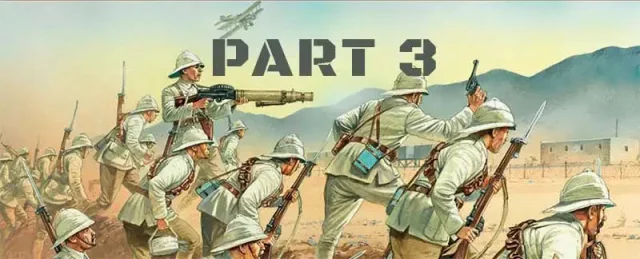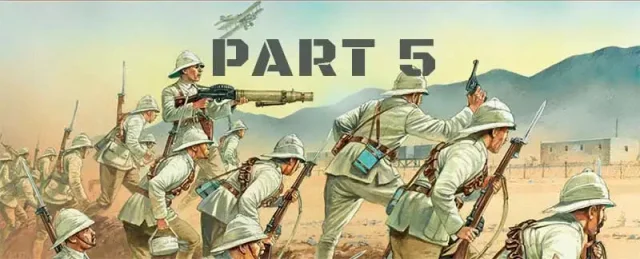- Military History
- Conflicts & Wars
- World War I
- Involved Nations WWI
- Arabia during World War I - The Arab Revolt - Part 4
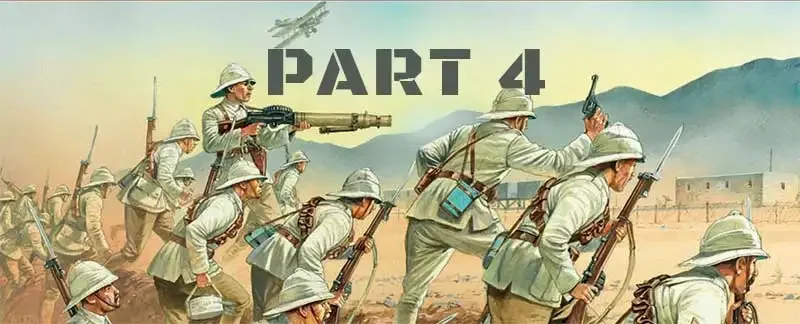
Arabia during World War I - The Arab Revolt - Part 4 July to November 1917 & The Final Campaign - Palestina and Syria (1917-1918)
Despite the positive trend, there were also a series of internal problems. Intelligence showed that the Turks were attempting to buy the loyalties of Auda abu Tayi and although he did not defect, such overtures were made to other Arab leaders, including Feisal, later in the campaign.
Index of Content (Part 4)
- The Arab Revolt (continued - more in the previous 3rd Part)
The Arab Revolt (continued)
July - November 1917
In the weeks that followed, supplies poured into Aqaba while the Royal Navy maintained a presence in the harbor to protect the port. Feisal’s army was moved from Wejh to Aqaba, the regulars being moved by ship while the irregular tribal force made the journey by camel. Lawrence, who had been promoted to major, requested that he be placed in command of Hedgehog, but this was refused. Colonel Joyce would remain in command at Aqaba.
The effects of the Sykes-Picot revelations were still being felt, and perhaps the Arab-British relationship had been fatally damaged and would never be the same. There were tensions within the Arab camp itself and Sharif Hussein increasingly tried to exercise control over Feisal. Despite the Arab success in taking Aqaba, an inertia fell over the Arab Northern Army and the momentum went out of the campaign.
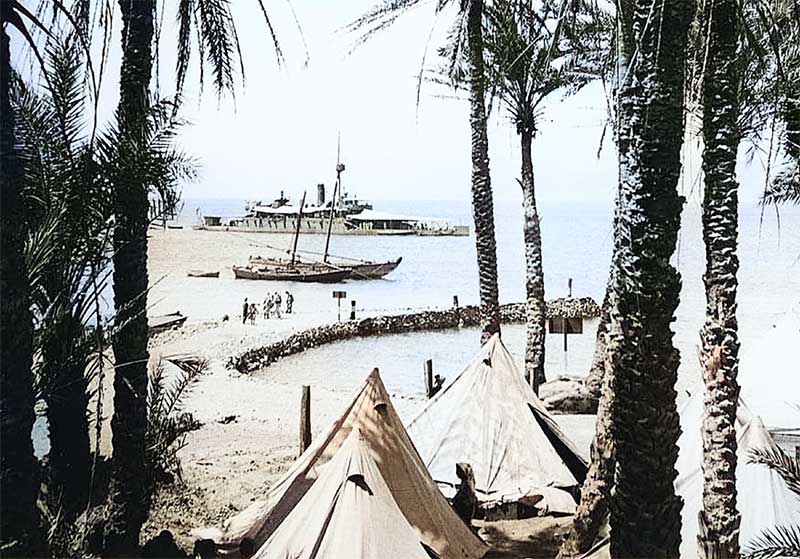
The move to Aqaba had also created an immediate military difficulty. The port was within range of Ottoman planes at Ma’an and was subjected to bombing raids on an almost daily basis. The flight of RFC planes that had been based at Yanbu was rushed up the coast to counter this threat and they soon were buzzing over Ma’an, which would become the focus of considerable attention over the following months.
Raids upon the railway continued and were carried out by Joyce, Newcombe, Lawrence, and various British and Arab officers. As further operations into Palestine were now planned, other activities were also planned to prepare for later campaigns. Long-range reconnaissance expeditions were undertaken to find overland routes into Palestine. There were also expeditions in search of sources of water. As the RFC was playing an increasingly important role in the campaign, Lawrence and his companions were constantly on the lookout for viable landing strips. In August 1917, Lawrence traveled into the Sinai to find and set out a rudimentary airstrip. This was then stocked with fuel and bombs and could be used by planes flying from Egypt on missions to bomb Ma’an and other Turkish outposts.
During the night of 17 September, Lawrence led a raid against the station at Mudawwarah, which lay almost directly due east from Aqaba. His intention was to destroy the well there and success would have meant that there was no significant source of water for the railway for over 240 km (150 miles). He was accompanied by tribesmen and two British Army NCOs, Sergeant Yells and Corporal Brook, who were experts in using the Lewis gun and Stokes mortar, respectively. The Turkish garrison of over 300 men was more than twice the size of Lawrence’s force, and a direct assault was ruled out. He lay a large mine on a nearby bridge, which he detonated as a train of ten wagons, pulled by two locomotives, were passing over it.
The result was a spectacular train wreck, and Lawrence carried out further demolitions on one of the damaged locomotives to put it beyond repair. All the while, he and the Arabs were covered by Yells and Brook firing their Lewis gun and Stokes mortar at the approaching Turks. He also later noted that the wrecked train had been carrying both women and sick. Despite his outward bravado, such events took a heavy toll on Lawrence. As he wrote to a friend around the same time, ‘nerves going and temper wearing thin’.
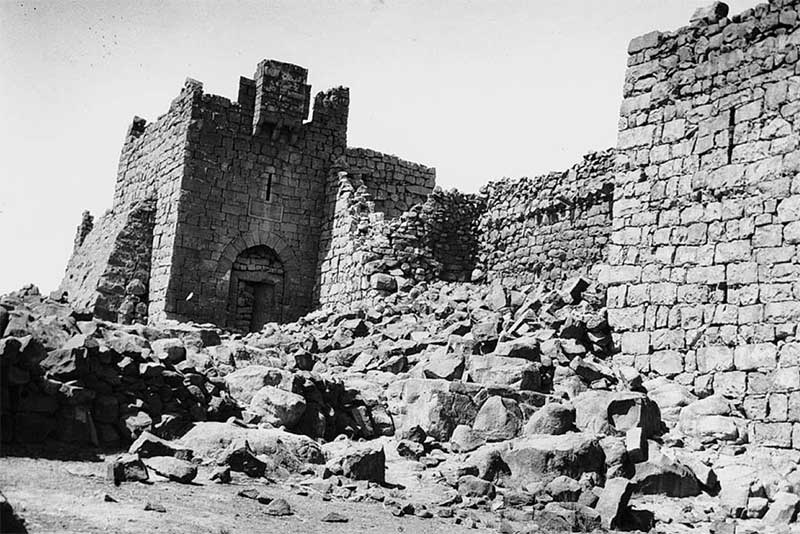
After further railway raids, he undertook with Capitaine Pisani of the French mission, Lawrence went to Cairo for a meeting with General Allenby. They discussed possible operations that could be mounted to support wider British plans. A Syrian uprising was ruled out and Allenby asked Lawrence to mount a raid into the Yarmuk Valley in order to cut the branch line of the Damascus-Medina line that ran through it. This was a vital artery between Palestine and Syria, and the raid was to coincide with Allenby’s planned offensive on the Beersheba-Gaza line, which was timed for the end of October. If Lawrence could cut a major bridge across the valley, it would prevent Turkish supplies and reinforcements from reaching the front line. It was also hoped, if the offensive was successful, the Ottoman Army could not retreat out of Syria if the line was cut. Allenby asked him to do this during the night of 5 November, or during the three following nights. Such a deep penetration mission into Turkish-held territory was viewed by some of Lawrence’s fellow officers as a suicide mission.
Lawrence left Aqaba on 24 October 1917 with a raiding party of tribesmen. His party also included machine-gunners from the Indian Army and Lieutenant Wood, an expert in demolition from the Royal Engineers, who would supervise the demolition of the Yarmuk Valley Bridge. This was a crucial mission, but one that was to lurch from one crisis to the next. Among the group was Abd al-Qadir (or Abd el-Kader) who lived among Algerian exiles in the Yarmuk. He was descended from the Abd el-Kader (1808-83) who had led North African tribesmen in their resistance to the French in the late 19th century. Colonel Brémond of the French mission had warned Lawrence that al-Qadir was a Turkish spy, a warning that Lawrence ignored. During the night of 4 November, al-Qadir and his men disappeared; the mission had been compromised. It also proved difficult to recruit the tribesmen of the Serahiyyin, who feared local reprisals.
Lawrence pressed on. Having secured the support of some of the local Serahiyyin, his small force set out to blow the bridge at Tel ash-Shehab during the night of 7 November. The attack descended into shambles. During their approach march, a local farmer fired on them, taking them for raiders. It drizzled rain and, as Lawrence crept towards the bridge with the explosives, a tribesman dropped his rifle, the noise alerting the Turkish guards. As the Turkish soldiers fired into the darkness, Lawrence’s party scattered. The tribesmen carrying the explosives abandoned this hazardous cargo, fearing that they would be blown to smithereens if a bullet should hit one of their boxes. When the party finally re-assembled, Lawrence found that they no longer had enough explosives to destroy any of the bridges over the Yarmuk. The mission was aborted. As Lawrence retreated, he could hear the British artillery in the distance.
During their retreat, Lawrence and his men mined the line at Minifir, north of Deraa, destroying two culverts and a train being pulled by two locomotives. Since he had not enough cable, he had to detonate the mine too close to the track. He later wrote ‘when I peered through the dust and the steam of the explosion, the whole boiler of the first engine seemed missing. Just in front of me was the scalded and smoking upper half of a man.’
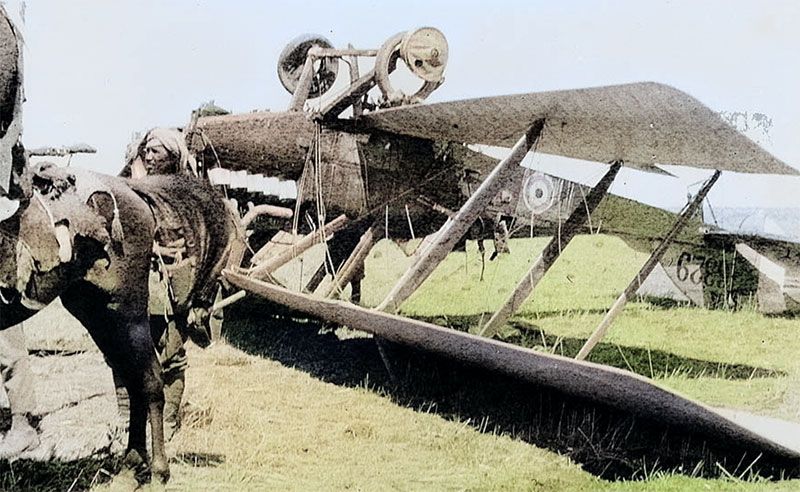
It turned out that the train was that of General Mehmed Cemal Pasha (‘Mersinli’), commander of the Ottoman VIII Corps. The party returned to its base at the castle at Azrak, east of Amman, on 12 November. The next days in Lawrence’s life remain surrounded in mystery. It is known that he remained at Azrak for some days and during this time met with Syrian leaders, including Talal al-Haraydhin of Tafas. According to his later account in Seven Pillars of Wisdom, he traveled to Deraa to explore the town and arrived there around 20 November. There, he claims he was captured by the Turks and subjected to a rape. This entire episode remains the focus of debate. Some Lawrence scholars have found inconsistencies in the recorded dates in his field journals. While the modern consensus on this episode seems to tend towards disbelief, it will remain a topic of contention for everyone interested in the Lawrence story.
What is certain is that he returned to Aqaba on 25 November. In his absence, the Arab Northern Army had not been idle. In early October, Col. Joyce and Maulud al-Mukhlis had led a party of over 300 men of the Arab Regular Army on a raid to the west of Ma’an. During this expedition, they captured the old Crusader fort at Shawbek, which was being used as a Turkish garrison. They remained for just a short time, realizing that to stay would invite retaliation against the local population. Joyce and al-Mukhlis realized that this was a subtext to all the plans to incite revolt in Syria. The Syrian tribesmen would have to have Allied help to hand before they could rise in revolt. Otherwise, they would suffer from Turkish reprisals.
On 21 October, a large Turkish force attacked the Arab Regular Army outpost at Wadi Musa near Petra. Commanded by al-Mukhlis, this small force held its ground and drove off the Turkish attackers with heavy loss. The Arab Regular Army had come of age and was ready to play an important role in the forthcoming campaigns.
The Arab Army at Aqaba had also been significantly reinforced. Capitaine Pisani now commanded a battery of French mountain artillery. Armored cars had previously worked with the Arabs in the fighting around Yanbu, and a squadron of Rolls-Royce armored cars had been attached permanently to Feisal’s Army in November 1917. A squadron of Talbot cars, some of which carried 10-pounder guns, and some Ford light cars supplemented these. This increased both the mobility and firepower of the Arab Army and throughout December, Joyce and Lawrence tested these cars over the rough ground of Wadi Ithm and also along the improved roads that were being built around the port.
Despite these improvements, this was not a positive time for the Arab Revolt. On taking power in Russia, the Bolsheviks had leaked the full details of the Sykes-Picot Agreement. The negative fallout from this was exacerbated when details of Arthur Balfour’s support of a Jewish homeland in Palestine became known. Balfour, who was then the Foreign Secretary of the British Government, had written to Lord Rothschild in early November 1917 stating that the Government supported Jewish claims for a homeland in Palestine.
This letter was published in The Times on 7 November. It could not have come at a worse time for the Arab Revolt. Already filled with doubts about their alliance with the British, the Arab leaders now looked to the future with some scepticism. The Ottoman leaders wasted no time and Cemal Pasha (commander of Fourth Army and Governor of Syria) made conciliatory speeches in Damascus and contacted the Arab leaders, announcing an amnesty for past transgressions. In November, a train was ambushed north of al ’Ula and was found to be carrying over £24,000 in gold. This money was to be used to buy back the Arabs. The Arab Revolt had reached yet another critical juncture. Owing to the considerable diplomatic skills of Lawrence and other officers, the Arab leaders were kept on side. The Allied cause was much helped by the capture of Jerusalem on 9 December 1917. To even the most sceptical of the Arab leaders, the Ottoman star was in the descendant. The Arabs also felt that they had a powerful ally in America. In his famous ‘Fourteen Points’ speech, delivered in a joint session meeting on 8 January 1918, President Woodrow Wilson declared that the ‘other nationalities which are now under Turkish rule should be assured an undoubted security of life and an absolutely unmolested opportunity of autonomous development’.
Perhaps the conditions of the final settlement of the former Ottoman territories could be re-negotiated at the end of the war.
The Final Campaign, Palestine and Syria, December 1917 to October 1918
While November 1917 had been a time of disappointment and also acrimony between the Arab leaders and the officers of Hedgehog, the year ended on a more positive note. Military successes in December 1917 and January 1918 suggested that perhaps a new and decisive phase of the campaign was about to begin.
Since the arrival of the Rolls-Royce armored cars and the Talbot car battery, Lawrence, Joyce, and other officers had been experimenting with their use. They tried them over different terrain, and this allowed Lawrence to indulge in his love for speed. Sam Rolls, one of the armored-car drivers, later wrote of how Lawrence urged him onwards, until the speedometer hit 113kph (70mph).
To prepare for further expeditions, depots were laid down to the east of Aqaba. Joyce, Lawrence, and other officers realized that this comparatively small group of cars actually represented quite a strong mobile force and they used them in a long-range raid against the important railway station at Mudawwarah.
They set out on 26 December 1917 and, on reaching the railway line, engaged in a reconnaissance of the station and the surrounding area. They found they were impregnable to Turkish rifle and machine-gun fire, and Lawrence would later describe this as ‘fighting de luxe’. While they decided that the station was too strong for them, they destroyed some railway wagons and also shelled the nearby station at Tell Shahm, using the 10-pounders mounted on the Talbot cars.
The irregulars of the Arab Northern Army were also far from idle. A force of over 1,100 tribesmen and Arab regulars, commanded by Sharif Nasir and Nuri as-Sa’id, opened the new year by seizing Abu al-Lissan, the site of an important well between Aqaba and Ma’an that had been retaken by the Turks. They then continued to carry out a raid on the line north of Ma’an, capturing the station at Jurf ad Darawish and over 200 Turkish soldiers.
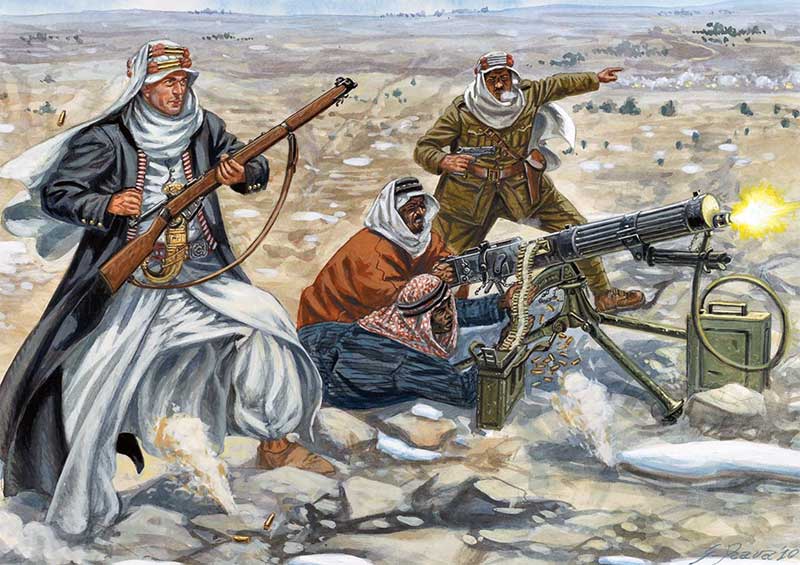
During its return journey, Sharif Nasir’s force captured the town of Tafila (also Et Tafilah). This small town, around 70 km (45 miles) north of Ma’an, was set in the fertile uplands of the Wadi Araba. It was in the middle of an important grain-producing region and was a vital source of food for the Ottoman Army. The Turks would try to recapture it and the Arabs prepared for a defense of the town. The Emir Zeid, the younger brother of Feisal, was sent to take charge of operations and Lawrence arranged for an urgent shipment of £30,000 in gold to be sent from Palestine to Tafila in order to raise levies of tribesmen, which could then support Allenby’s planned advance into Palestine.
Around 22/23 January, a composite brigade formed by units of the Turkish 48th Division left Kerak, to the north of Tafila, under the command of Lieutenant-Colonel Hamid Fakhri Bey. The size of this force remains unclear, with some sources stating that it numbered around 600 men while others state 1,000. As it included a cavalry force, infantry from the 151st and 152nd regiments and had two mountain guns and over 20 machine guns of different types, it may be safe to assume that it numbered around 900-1,000 men. Turkish sources number the infantry contingent alone as being 600 men, which would not seem unreasonable. This force reached the vicinity of Tafila on the evening of 25 January and there was some initial skirmishing to the north of the town. The next morning, the Turkish force attempted to retake the town and put in their major assault around midday. Nasir, Lawrence, and the other Arab leaders had only around 600 men, four mountain guns and around a dozen light machine guns to counter this superior Turkish force.
The battle of Tafila has been largely forgotten in the revolt’s history, but it can be viewed as one of the major achievements of the Arab Army.
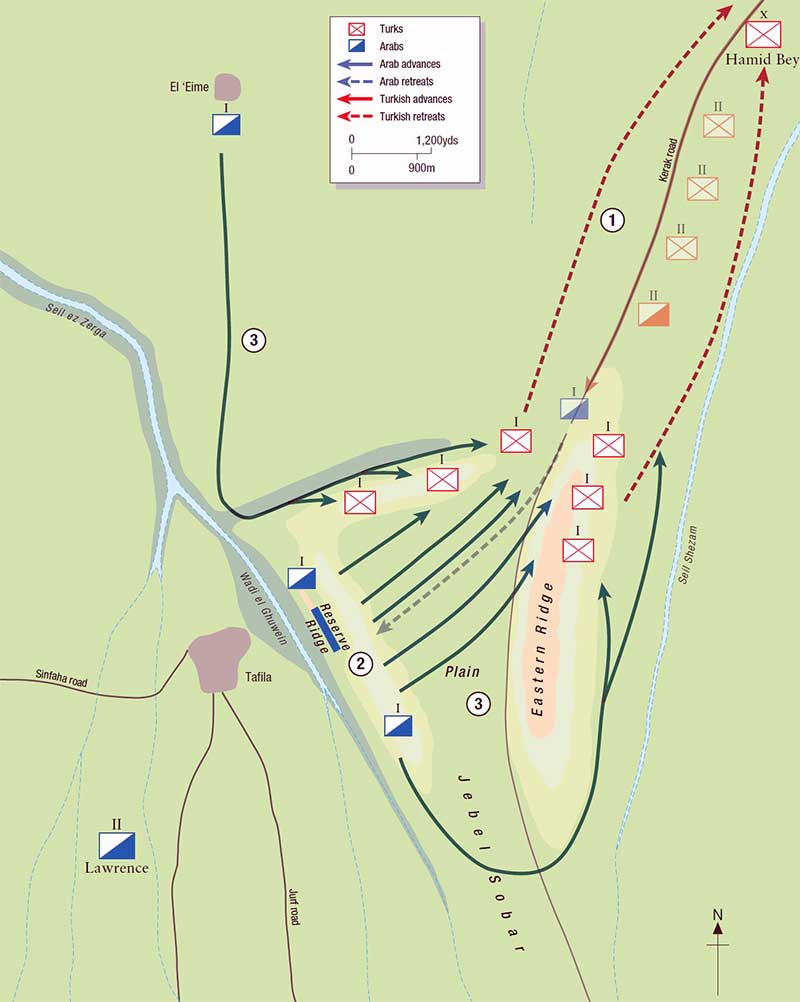
They initially opposed the Turkish force to the north of the town but were driven back to occupy a ridgeline facing the Turkish troops. Lawrence later referred to this as the ‘Reserve Plateau’ or ‘Reserve Ridge’. The Turks occupied two ridgelines to the north of the town, and a brisk firefight developed that lasted for most of the afternoon. In this exchange, the Arabs made the better use of their artillery. Towards 4pm, further Arab tribesmen arrived from the north and they put in an attack on the Turkish right flank. The original force on the ‘Reserve Ridge’ then put in a simultaneous frontal assault and an attack on the Turkish left flank. Faced with this three-pronged attack, the Turkish force faltered and broke. The remnants of the Turkish brigade retreated northwards towards Kerak. Around 200 men had been killed while over 250 were captured. The prisoners included Hamid Fakhri Bey, who had been mortally wounded while trying to rally his troops. He died later that evening.
Lawrence was typically disingenuous in his later comments on the action, saying that he had sent in a semi-satirical report to GHQ, portraying the battle as though he had taken part with a copy of Clausewitz’s On War in his hand. He was awarded a DSO. Soon afterwards, tribesmen destroyed the fleet of small Turkish boats that ferried supplies across the Dead Sea. It was a remarkable success by an irregular force against a superior force of regular soldiers commanded by an experienced officer.
The euphoria over Tafila was short-lived. Finding that Zeid had already spent the £30,000 that was intended for the new campaign, Lawrence departed for a meeting with Allenby, totally disillusioned with the revolt. While GHQ was prepared to overlook the loss of these funds, the plans by Allenby and Lawrence for combined efforts had limited success. Further Arab operations were planned to support Allenby’s advance on Amman. It was decided that a major attack would be launched against Ma’an on the Turkish left while the main British effort was concentrated on Amman. Ultimately, both components of this combined operation failed. While the British offensive took Es-Salt and advanced towards Amman, a major Turkish counterattack was launched on 2 April, which drove them back.
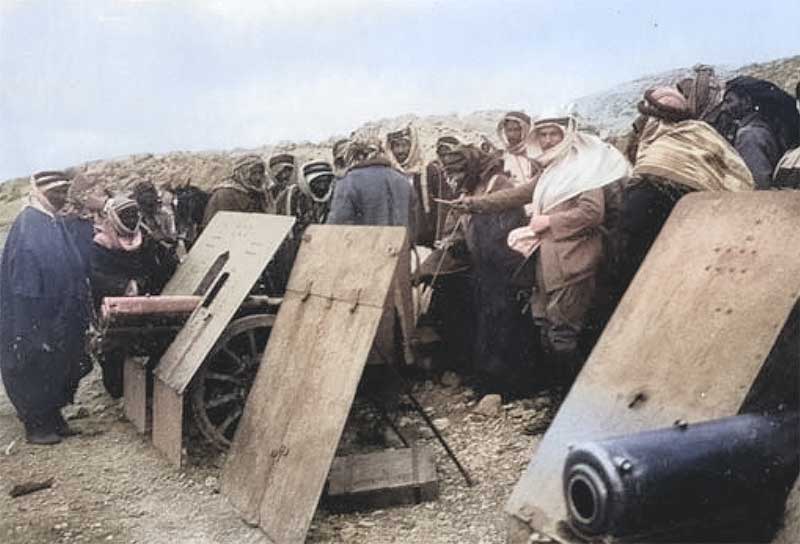
To the south, Jafar Pasha al-Askari led the Sharifian Regular Army of around 4,000 men in an offensive near Ma’an. The original plan had been to cut the line to the north and south of this major action. But senior officers within the Arab Army, including Nuri as-Sa’id were confident that they could take the town of Ma’an in a concerted campaign. An initial attack on the station complex at Jardunah was a success, although the position was heavily entrenched. When the attack had stalled, Jafar Pasha al-Askari unleashed his violent temper and a torrent of abuse that spurred his men on. The Arab regulars stormed the trenches and took the surrender of around 200 Turkish soldiers.
The attack on Ma’an proved more problematic as a network of trenches and redoubts surrounded it. On 13 April, Maulud al-Mukhlis led an attack on the outlying redoubt at the Jebal Simnah to the west of Ma’an and was wounded in the process. The attack on the main garrison, numbering over 4,000 men, stalled amid fierce fighting on 16 April. While some of the Arab troops had penetrated the Turkish wire and advanced as far as the station on 17 April, they could not consolidate their gains and had to fall back on the Jebal Simnah.
The Ma’an situation settled down to a siege that would last until the end of the war. Further raids by tribesmen, the armored cars and the camel corps cut the line to the north and south. The Ma’an garrison was now be cut off in the same way as the Medina garrison was further south. They were, however, strongly entrenched, and able to withstand further Arab attacks. Jafar Pasha’s request to be allowed to use mustard gas to break the siege was later refused.
Attempts to negotiate a surrender of the garrison also failed when they were reinforced by 3,000 troops from Amman. To compound these setbacks, Allenby’s second advance on Amman was also turned back in late April. These reverses could not have come at a worse time for the entire campaign in the Middle East. Owing to the German Spring Offensives of March 1918 on the Western Front, Allenby’s Army was stripped of divisions in April and May.
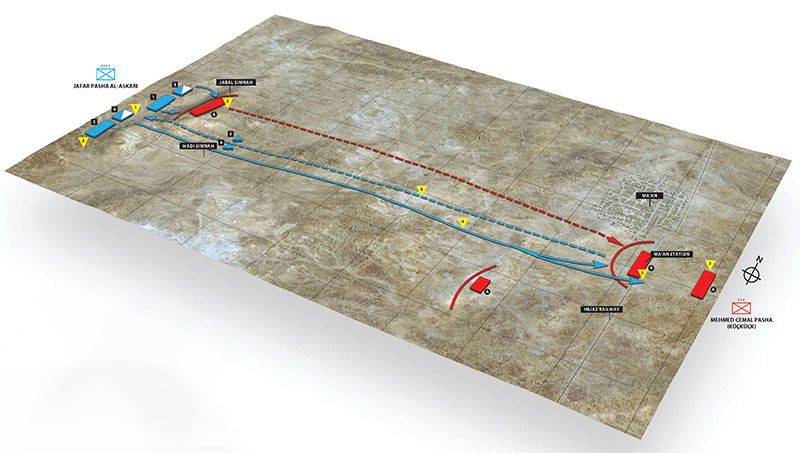
This restricted Allenby in terms of offensive action, and the combined Turkish and German armies that faced him could merge their defenses. They could even engage in offensive action and Liman von Sanders launched a surprise offensive in mid-July, which was eventually beaten back.
For Lawrence and the leaders of the Arab Revolt, they redoubled their efforts against the railway. Operation Hedgehog was now commanded by Colonel Alan Dawney, and with Lawrence and other British officers, he launched a series of major raids using tribal forces, the armored cars, air support, and a contingent from the Imperial Camel Corps. These attacks were far too many to detail here, but they took place throughout the summer of 1918. In May 1918, alone, 25 bridges were demolished along the course of the railway.
In one of the most spectacular attacks, on 8 August 1918, Major Robin Buxton and his contingent of the Imperial Camel Corps captured the station at Mudawwarah. Mudawwarah was heavily defended and when the ICC had cleared all but one of the Turkish redoubts, RAF planes that were in support bombed the ultimate position and forced its surrender. It shows the level at which the desert forces had evolved by this stage of the war.
The ultimate phase of the Arab Revolt was timed to coincide with Allenby’s Megiddo Offensive of late September 1918. Having engaged in a plan of misdirection to confuse the enemy regarding his true intentions, Allenby planned to break through on a narrow front at Megiddo. His intention was then to use the Desert Mounted Corps to exploit the break-through and capture strategic towns and passes. Using air power would be vital and, in Allenby’s best-case scenario, crucial enemy units such as the Turkish XXII Corps would be cut off and effectively destroyed. British forces would follow a coastal and also an upland route and converge on Damascus.
The Arab Northern Army played a crucial part in this plan. Feisal was to assemble the Arab Northern Army to the east of the river Jordan. When the major offensive began, this would tie down Turkish forces and make the Turkish commanders nervous about the integrity of their eastern flank. In the weeks preceding the offensive, Lawrence and the other Arab leaders embarked on a recruiting tour and also organized a huge supply train using over 1,500 camels supplied by Allenby. At the beginning of September 1918, the Arab Northern Army assembled for the last campaign. Its main striking force contained around 450 Arab regulars and a tribal contingent made up of men from the Howeitat, the Rwalla, the Bani Sakhr, Agyal and as well Druses and villagers of the Hauran. Their tribal leaders included Auda abu Tayi, Mohammed adh-Dhaylan, Nuri ash-Sha’alan and Talal al-Haraydhin.
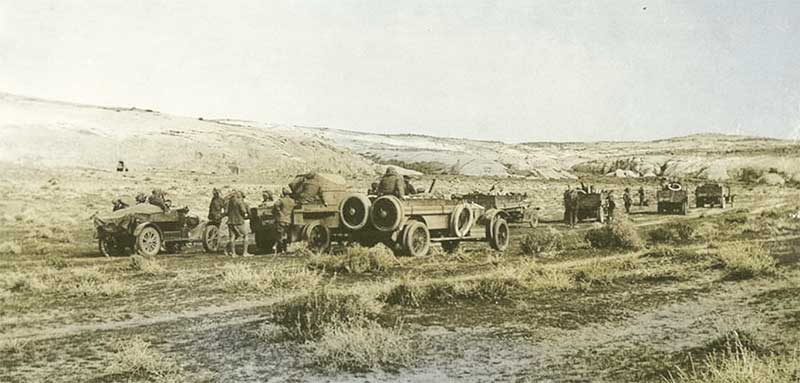
Attached to this force there was also a party of camel-mounted Gurkhas, Egyptian Camel Corps and Capitaine Pisani and his Algerian gunners. The armored-car squadron would also accompany them and during operations Bristol Fighters of the RAF and, on one occasion, a Handley- Page bomber would support them. In the middle of September, this small army of just over 1,000 men assembled at El Untaiye, to the south-east of Deraa. Feisal would later take this army slightly further south to Umm Es Suret to avoid being bombed by planes from Deraa.
Allenby had set 19 September for the beginning of the Megiddo offensive and, in the days before this, the Arab Army attacked the railway line to the north and south of Deraa. Effectively cut off, the Turkish garrison made enormous efforts to repair this line. Bridges were destroyed, six kilometers (four miles) of line were demolished and the line north of Mafraq station was also cut. Deraa, an important station on the line to Damascus, was isolated before the offensive began. Despite the pressure that the Turks were under, Lawrence and his force did not have it all their own way. They were driven away from the line by Turkish camel corps and frequently shelled by both Turkish and German aircraft.
The progress of the major offensive was good and, as the Turks reeled backwards, the forces facing the Arab army lost their cohesion. It was the beginning of the end. On the morning of 27 September, the Arab force was encamped near the village of Tafas when it received news that two Turkish columns were converging on the area. One was of 6,000 men out of Deraa, while the other of 2,000 was coming from Mezerib. It was agreed that the second smaller column would be attacked as it passed the village.
The sequence of the events that followed is still hotly debated. The Turkish soldiers had massacred the villagers of Tafas in reprisal. It has also been established that Talal al-Haraydhin, whose village this was, died in an attack on the Turkish column. Supported by Pisani’s artillery, the rest of the Arabs then put in an attack on the retreating Turks. Included among the Turks were also some German and Austrian troops who put up a fierce resistance. Lawrence later wrote that he issued a ‘no prisoners’ order at the beginning of the attack and those who tried to surrender were shot or cut down on the spot. The real controversy surrounds those who surrendered, who numbered around 250 men and included Germans and Austrians. After the war, Lawrence confided in a letter to his brother that he ordered them to be machine-gunned. It is still unclear if this actually happened and, if it did, if he had sanctioned it.
Some suggest that the rape he suffered at Deraa in 1917 had brutalized Lawrence and that this excuses his actions at Tafas. Whatever the truth, he described the event in horrific detail in his memoir, Seven Pillars of Wisdom: ‘In a madness born of the horror of Tafas we killed and killed, even blowing in the heads of the fallen and of the animals; as though their death and running blood could slake our agony.’
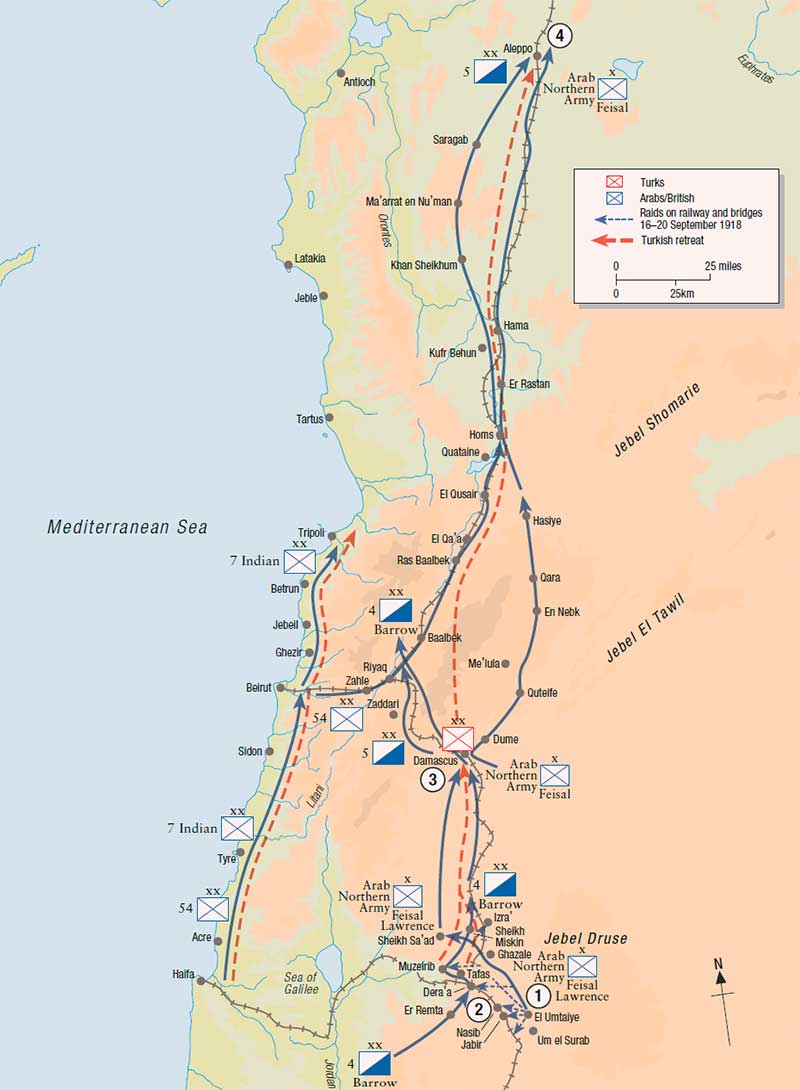
The Turkish resistance was reaching its death agonies. Now totally isolated, the garrison of 4,500 men at Ma’an evacuated the town and began a long march to the north. Constantly harassed by tribesmen, they surrendered to British forces in Transjordan on 28 September. On the same day, the Arab Army and the leading elements of General Barrow’s 4th Cavalry Division reached Deraa. On their arrival, Barrow’s men found Arab tribesmen slaughtering wounded Turks on a hospital train in the station. The British troops restored some kind of order, but it was a grim epilogue to the events at Tafas.
There was now no real organized resistance between Deraa and Damascus. Turkish soldiers were surrendering to their thousands. The Arab Army swept on to Damascus, reaching that ancient city on 1 October along with elements of the 5th Cavalry Division and the Australian Mounted Division. Lawrence had sped northwards in a Rolls-Royce he had christened ‘Blue Mist’. Any jubilation was short-lived. At a tense meeting in the Victoria Hotel on 3 October, Allenby informed Feisal of the French claims to Syria and was astonished to find that Lawrence had not explained the details to him. While Feisal could govern Syria, it would be under the guidance of the French. The Arabs had shaken off their Ottoman overlords only to find them replaced with the French. The meeting ended inconclusively and boded ill for the future.
The pursuit of the Turks continued to Aleppo, which fell to Arab troops on 26 October. When Arab and British troops seized Muslimiya Junction on 29 October, the Allies effectively controlled the Turkish rail link to Mesopotamia. The Ottoman Empire was granted an armistice on 31 October. The Arab Revolt was at an end. Promoted to full colonel, Lawrence returned to England. Feisal and his followers faced an uncertain future. As James Barr pointed out in one of his studies of the revolt, it was the success of the Arab Revolt that made the bad faith of the Allied leaders even more apparent.
Read the previous part:
Read the next and final part of the series:
- {{#owner}}
- {{#url}} {{#avatarSrc}}
{{name}} {{/url}} {{^url}} {{#avatar}} {{& avatar}} {{/avatar}} {{name}} {{/url}} - {{/owner}} {{#created}}
- {{created}} {{/created}}


